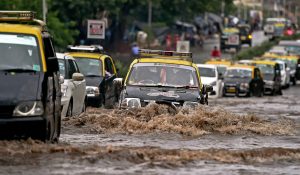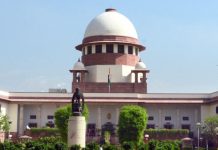
The first rains of the monsoon lash Chandigarh while Ridhhi is on her way home from work. As she approaches Railway crossing number 126 at Manimajra, Chandigarh, a barricade, a gaping pit and a huge mound of dug-up earth greet her. She sighs, “Another road ravaged just before the rains! Why do they always start the construction work so close to the monsoons?” The said railway crossing is closed for the construction of a Railway Under-Bridge (RUB), the work on which has already been delayed by almost six years. As much as the project would ease traffic jams, the question arises that why would the local civic body green-light such a tedious project during the rainy season, even though said rains would hamper the construction work. As we shift our gazes to some other premier cities in India, we find the phenomenon is an oft-repeated one.
One must remember that modern meteorological and environmental science helps forecast weather well in advance. An efficient government can plan strategies well in advance to cope with the challenges no matter how unusual they are. Along with the building of huge bridges and underpasses during monsoons (which often turn into ponds after a heavy rain ), there is a dire need for a sustainable mechanism to manage the annual monsoon season. So why do the roads fall to pieces every year, even though we have just four months of monsoon?
Cities in bad road woes
Roads have existed in India for the last 5,000 years. India has a road network of over fifty-lakh kilometres, the second largest in the world. About 63 percent of these roads are paved. Civic bodies and road contractors play the blame game every year by deflecting the responsibility for damaged roads on each other. All line departments have to work in tandem to deal with the challenges of monsoons, which seldom happens. Lessons have to be learnt from repeated monsoon havoc on these roads to devise effective strategies for future. Roads in India are subject to extreme temperature variations; hot and humid summers, monsoons and harsh winters, resulting in subsequent contraction and expansion of base materials. Moreover, specifications have not been changed in proportion to the rise in the number of vehicles. Water stagnation and traffic jams put further pressure on roads. The top layer of the road, which used to be 40-mm thick, is now reduced to 25 mm. The layer below, made of blue metal stones, has been reduced from 70mm to 50 mm. A civic body official from Ludhiana confessed, ”Using building debris for filling potholes was not in the list of approved filling materials. Yet contractors continue violating regulations. They hike project costs and timeframes midway. We have to keep mum due to political pressure.”
Usually, the lifeline of a road starts when it is sanctioned by the Transport Ministry. The projects involve contractors, brokers and politicians who want their share of business, commission and votes respectively. A road contractor from Mumbai lamented,”The civic body doesn’t give us the required number of road gullies and service ducts, adding pressure on the roads during heavy rains. The consulting agencies hired for planning and budget estimation for new roads give unrealistic targets. They seldom inspect the actual site. We underbid to keep our business alive. If we don’t, someone else will.”
Another contractor from Bangalore has a similar story to tell, ”Contractors of damaged roads are asked by the civic body to rectify the defects in ridiculously small time. Failing to complete the contracts can result in disqualification from further projects.” There is no minimum ceiling for the bid. Companies just try to win the contracts at any cost. Those making the roads indulge in heavy cost-cutting. This leads to the roads breaking in quick time. Thus, roads are made every year post monsoons and the overall expenditure exceeds the required cost.
Experts also point to the ever-increasing burden on roads in urban areas. Sports utility vehicles (SUVs, meant for off-road and highway travels) and luggage carriers can often be seen on city roads in peak hours. Such heavy loads further add stress to the road ecosystem.
The recent road over-bridge collapse at Mumbai’s Andheri railway station during a spell of heavy rain has raised concerns over the robustness of the city’s infrastructure. Vibhav Mehta, an Andheri resident, said, “Any structure, bearing so much traffic load needs regular inspection. Mostly, hasty patchwork is done on the roads just before monsoons to placate complaining residents of the area. The stormwater drains are not properly de-silted, adding to the burden on these overcrowded roads due to accumulation of stagnant water after a heavy rain.” Commuters on Delhi-Gurugram expressway were stuck in a monster jam, which lasted almost two days during the 2016 monsoon season. The civic authorities have done little in the past two years to prevent such incidents. Neha Arora, who resides in Gurugram and commutes to New Delhi for work, does not sound hopeful, “There was some road repair activity this year as well before the rains arrived. Sewage lines were laid in parts of the city. But the construction debris and the muck cleared from the road gullies was left on the side of the road. In case of heavy rains, the same waste material will block the road gullies again.” Hadley, a Bangalore resident, sums up his woes, “The biggest issue is for motorcyclists as it becomes very dangerous when all of a sudden a big bump appears from nowhere on these flooded roads. If you are aware of where the bump is, you will slow down only to be splashed with dirty rainwater from a car next to you. The situation is bad and although everyone is aware of it, no action is being taken. Pathetic road conditions are prevalent even on expressways and bridges where one pays toll tax to use the road. So where is all this money really going? Is it robbery in plain sight by our authorities?”
Contrary to popular perception in India, the subcontinent is not the only region at the receiving end of unrelenting rains. The UK is a developed country where it rains all throughout the year. According to recent estimates, 12 percent of UK roads are in very poor condition. Though the figures are better than India, sources say it would take about 14 years and £9.3bn to repair Britain’s roads properly. This proves the wrath of nature spares no-one.
There has been no major upward or downward trend of rainfall for the last few centuries but a decrease in rainfall in the last two decades, with a contrast record of increasing floods, has been experienced in cities like Chennai, Kolkata, etc. Thus, the oft-cited reason by the administration for urban floods-heavy rainfall in a few hours – does not hold. It is only an excuse for bad planning in the cities. The number of water bodies in all major cities of India has drastically come down over the last three decades. The floodplains and lakes in the low-lying parts of a city did not just fulfill the water needs of a city but also drained it off the excess rainwater that poured there. When construction blocked the path of water, it led to water-logging on the city roads. The blame then fell on the storm water drains which in most cases, were designed very long ago, assuming half the water would be absorbed by the soil. With the onset of rampant and indiscriminate urbanisation, most areas are now paved. As a result, very little rainwater is absorbed into the ground. Even at one inch per hour, the drainage system is coping with almost twice its intended capacity.
A way out
Though efforts are being made to find lasting solutions, they are too few and the implementation is too tedious due to the extent of the problem and the red tape involved. A scientist near Bangalore is working on self-healing roads that resist heavy rains, intense heat and poor drainage. Some experts suggest replacing Bituminous (BT) roads with Cement Concrete (CC) roads, which are more durable and easier to repair. But the real need of the hour is urban rainwater harvesting. Recharge wells and harvesting ponds need to be constructed in low-lying areas as well as around storm water drains, to collect excess rainwater. In countries like the Netherlands, the roads are constructed with a material that absorbs rainwater, which also allows for recharging of groundwater. This can be a boon in agricultural states like Punjab, where the groundwater levels have reduced to alarming levels. New roads should be designed to incorporate the needs of the local terrain, climate and population.
After a harsh spell of a typical summer in the Indian sub-continent, rain is welcomed as a blessing from the skies. In a country like India, with its extreme and varying terrain, roads form a lifeline by being the most flexible means of transport as they can handle high gradients, sharp turns, et al. The condition of roads during the monsoons gives a true picture of their quality. The difference can be seen in roads managed by BRO (Border Roads Organization), which face extreme weather and still remain in better condition than some big city roads. While those maintained by urban civic authorities are often ridden with potholes; these are not just minor potholes, but big craters at many places. Governments change but the condition of our roads doesn’t. The only changes occur is names of policies, e.g. from Jawaharlal Nehru National Urban Renewable Mission (JNNURM) to Atal Mission for Rejuvenation of Urban Transformation (AMRUT).
Alas, the governing authorities cannot be held solely responsible. To avoid the wrath of the rains, we need to embrace the monsoons rather than try to fight against them. A sustainable Private Public Partnership (PPP) model is required to manage the monsoon season in urban areas. If public and private entities take charge of managing rainwater in their respective areas, by constructing feasible water harvesting and drainage systems, the burden on storm water drains and road gullies would reduce and the problem of water-logged roads will go away by itself.
letters@tehelka.com













